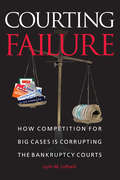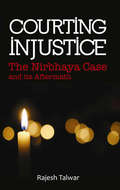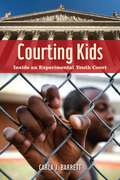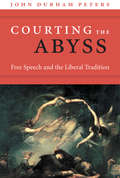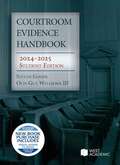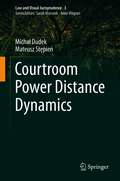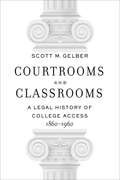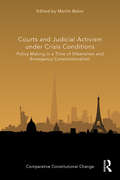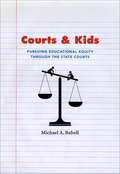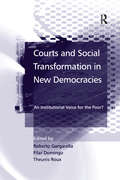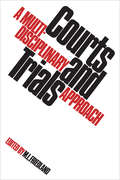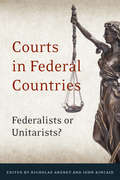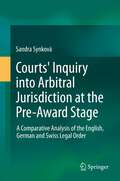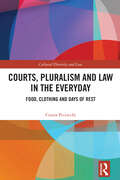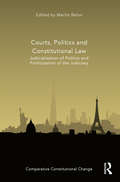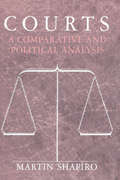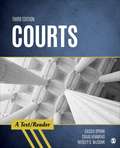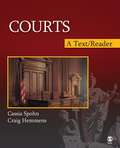- Table View
- List View
Courting Failure
by Lynn M. LopuckiLoPucki's provocative critique of Chapter 11 is required reading for everyone who cares about bankruptcy reform. This empirical account of large Chapter 11 cases will trigger intense debate both inside the academy and on the floor of Congress. Confronting LoPucki's controversial thesis-that competition between bankruptcy judges is corrupting them-is the most pressing challenge now facing any defender of the status quo. " -Douglas Baird, University of Chicago Law School "This book is smart, shocking and funny. This story has everything-professional greed, wrecked companies, and embarrassed judges. Insiders are already buzzing. " -Elizabeth Warren, Leo Gottlieb Professor of Law, Harvard Law School "LoPucki provides a scathing attack on reorganization practice. Courting Failurerecounts how lawyers, managers and judges have transformed Chapter 11. It uses empirical data to explore how the interests of the various participants have combined to create a system markedly different from the one envisioned by Congress. LoPucki not only questions the wisdom of these changes but also the free market ideology that supports much of the general regulation of the corporate sector. " -Robert Rasmussen, University of Chicago Law School A sobering chronicle of our broken bankruptcy-court system,Courting Failureexposes yet another American institution corrupted by greed, avarice, and the thirst for power. Lynn LoPucki's eye-opening account of the widespread and systematic decay of America's bankruptcy courts is a blockbuster story that has yet to be reported in the media. LoPucki reveals the profound corruption in the U. S. bankruptcy system and how this breakdown has directly led to the major corporate failures of the last decade, including Enron, MCI, WorldCom, and Global Crossing. LoPucki, one of the nation's leading experts on bankruptcy law, offers a clear and compelling picture of the destructive power of "forum shopping," in which corporations choose courts that offer the most favorable outcome for bankruptcy litigation. The courts, lured by big money and prestige, streamline their requirements and lower their standards to compete for these lucrative cases. The result has been a series of increasingly shoddy reorganizations of major American corporations, proposed by greedy corporate executives and authorized by case-hungry judges.
Courting Injustice: The Nirbhaya Case and Its Aftermath
by Rajesh TalwarIn this partnership between so-called equals, which can be compared to a polyandrous marriage, the Supreme Court is the woman and Parliament and the Executive her two husbands, one more loutish that the other, depending on your point of view. In the Nirbhaya case too the gap between theory and law has been highlighted. Following the terrible episode, (and even before) there has been continual and great improvement in the substantive laws for both women as well as children who have been victims of sexual violence. And yet despite their being so much publicity on the case, the author argues that, concretely, although there has been improvement in the laws themselves, we are nowhere near better enforcement or implementation. Even after the institution of a fast track trial, and with the nation’s attention focused on it, the Nirbhaya case still dragged on and it took more than nine months for the trial court to reach a verdict. And, as the author explains there are still potentially further delays waiting at the level of the superior courts, the High Court certainly and the Supreme Court too, quite possibly. As the author goes on to show in this well argued book, a woman who is the victim of a sex related crime ‘courts injustice’ whenever she comes to a court, be she the victim of a rape, an acid attack, of sexual harassment; the mother or father of such a victim or be it even any ordinary person struggling to find justice. Our courts, particularly the Supreme Court is performing the function of a nagging wife. Time and again she pulls up the lazy, good-for-nothing husbands (read ‘failure of governance’). And what does either husband do? He goes for a walk, ignoring the wife’s anguished screams even as they follow him. If she complains too much, he tells himself, he’ll see to it that she doesn’t get the silk sari and other goodies she wants (read ‘promotions’, ‘post retirement assignments’, etc). It is only one of the ways he ensures that she doesn’t step too much out of line. All wives nag, he consoles himself. Nagging here and there is tolerable but she must make sure that he gets his meals on time (read ‘doesn’t bar him from contesting elections even if there are a dozen or more criminal cases pending against him’). Meanwhile the overzealous wife doesn’t realize that while she rails and rants against the erring ways of her husband, the dishes are piling up in the kitchen. And the maid has gone away for six months and the dishes, they are piling up (read, the arrears are accumulating)! The time has come. It cannot continue to remain ‘business as usual’. There will be justice for Nirbhaya. Our ‘brave heart’ will also bring justice and relief to all her sisters. And possibly, even to the rest of us.
Courting Kids: Inside an Experimental Youth Court (Alternative Criminology #25)
by Carla J. BarrettDespite being labeled as adults, the approximately 200,000 youth under the age of 18 who are now prosecuted as adults each year in criminal court are still adolescents, and the contradiction of their legal labeling creates numerous problems and challenges. In Courting Kids Carla Barrett takes us behind the scenes of a unique judicial experiment called the Manhattan Youth Part, a specialized criminal court set aside for youth prosecuted as adults in New York City. Focusing on the lives of those coming through and working in the courtroom, Barrett’s ethnography is a study of a microcosm that reflects the costs, challenges, and consequences the “tough on crime” age has had, especially for male youth of color. She demonstrates how the court, through creative use of judicial discretion and the cultivation of an innovative courtroom culture, developed a set of strategies for handling “adult-juvenile ” cases that embraced, rather than denied, defendants’ adolescence.
Courting the Abyss: Free Speech and the Liberal Tradition
by John Durham PetersCourting the Abyss updates the philosophy of free expression for a world that is very different from the one in which it originated. The notion that a free society should allow Klansmen, neo-Nazis, sundry extremists, and pornographers to spread their doctrines as freely as everyone else has come increasingly under fire. At the same time, in the wake of 9/11, the Right and the Left continue to wage war over the utility of an absolute vision of free speech in a time of increased national security. Courting the Abyss revisits the tangled history of free speech, finding resolutions to these debates hidden at the very roots of the liberal tradition. A mesmerizing account of the role of public communication in the Anglo-American world, Courting the Abyss shows that liberty's earliest advocates recognized its fraternal relationship with wickedness and evil. While we understand freedom of expression to mean "anything goes," John Durham Peters asks why its advocates so often celebrate a sojourn in hell and the overcoming of suffering. He directs us to such well-known sources as the prose and poetry of John Milton and the political and philosophical theory of John Locke, Adam Smith, John Stuart Mill, and Oliver Wendell Holmes Jr., as well as lesser-known sources such as the theology of Paul of Tarsus. In various ways they all, he shows, envisioned an attitude of self-mastery or self-transcendence as a response to the inevitable dangers of free speech, a troubled legacy that continues to inform ruling norms about knowledge, ethical responsibility, and democracy today. A world of gigabytes, undiminished religious passion, and relentless scientific discovery calls for a fresh account of liberty that recognizes its risk and its splendor. Instead of celebrating noxious doctrine as proof of society's robustness, Courting the Abyss invites us to rethink public communication today by looking more deeply into the unfathomable mystery of liberty and evil.
Courtroom Evidence Handbook, 2024-2025 Student Edition
by Olin Wellborn III Steven GoodeNew book purchase includes complimentary digital access to the eBook. Designed both for law student advocates and students enrolled in traditional evidence courses, this handbook provides full coverage of courtroom evidence procedures, rules, and law. It contains the Federal Rules of Evidence, including recent and pending amendments; offers rule-by-rule commentary, serving as a mini-treatise on federal rules; and covers objections and responses. It is indispensable for students participating in a mock trial, going to court as part of a clinical program, or trying to understand the law of evidence. It also helps students bridge the gap from understanding the law of evidence to understanding how to perform at trial.
Courtroom Power Distance Dynamics (Law and Visual Jurisprudence #3)
by Mateusz Stępień Michał DudekThe book presents a comprehensive reconceptualization of Geert Hofstede’s well-known concept of power distance, applying the theory to the specific case of judge–witness courtroom interactions in Polish regional courts. In the light of the detailed critique of Hofstede’s original approach to power distance, the book first carefully develops a three-level concept of power distance, including personal preferences concerning the realization of power relations (subjective level); rules, practices and spatio-architectural arrangements underlying power relations (organizational level); and individual demeanors that can, in practice, increase or decrease the asymmetry between parties to a power relation (interactional level). This reconceptualization provides a universal conceptual apparatus that is applicable to various social settings, but the authors have used it in extensive qualitative and quantitative research focused on courtroom interactions. After laying the theoretical foundations, the book details the elements of judge–witness courtroom interactions (both verbal and non-verbal) that contribute to establishing power distance between judge and witness. These were identified over 6 months of observational research conducted in 2018 in the Kraków regional courts. Lastly, the book addresses the issue of the relationship between the subjective level of power distance and opinions that laypeople can have concerning a judge’s demeanor in the courtroom environment. To do so, it describes specific quantitative research that involved the creation of original film clips depicting witness questioning by the judge in a courtroom in three power distance situations. Offering a coherent framework for examining various interpersonal relations in legal contexts and illustrating how the framework can be applied on the courtroom interactions example, the book will appeal to a wide range of legal practitioners and academics. It also allows scientists outside the legal field to gain a new and broad understanding of power distance that they can easily apply in their respective fields. Furthermore, it provides non-academics with insights into courtroom interactional dynamics, as exemplified by the discussion of Polish judicial practice.
Courtrooms and Classrooms: A Legal History of College Access, 1860−1960
by Scott M. GelberA stunningly original history of higher education law.Conventional wisdom holds that American courts historically deferred to institutions of higher learning in most matters involving student conduct and access. Historian Scott M. Gelber upends this theory, arguing that colleges and universities never really enjoyed an overriding judicial privilege.Focusing on admissions, expulsion, and tuition litigation, Courtrooms and Classrooms reveals that judicial scrutiny of college access was especially robust during the nineteenth century, when colleges struggled to differentiate themselves from common schools that were expected to educate virtually all students. During the early twentieth century, judges deferred more consistently to academia as college enrollment surged, faculty engaged more closely with the state, and legal scholars promoted widespread respect for administrative expertise. Beginning in the 1930s, civil rights activism encouraged courts to examine college access policies with renewed vigor.Gelber explores how external phenomena—especially institutional status and political movements—influenced the shifting jurisprudence of higher education over time. He also chronicles the impact of litigation on college access policies, including the rise of selectivity and institutional differentiation, the decline of de jure segregation, the spread of contractual understandings of enrollment, and the triumph of vocational emphases.
Courts and Congress: America's Unwritten Constitution
by William QuirkIt's often said, confirmed by survey data, that the American people are losing confidence in their government. But the problem may be the reverse--the government has lost confidence in the people. Increasingly the power to make decisions in our democracy has been shifted from Congress to the court system, forcing non-elected officials to make decisions which affect the lives of Americans. In a society which is based on the democratic elections of its officials, this is clearly backwards.Quirk maintains that what he calls "The Happy Convention," an informal and unwritten rearrangement of "passing the buck" of government powers, is done to avoid blame and approval ratings becoming lower for a particular person or party. For example, The Happy Convention assigns the power to declare and make war to the President. Congress and the Court play a supporting role--Congress, when requested, gives the President a blank check to use force--the Court throws out any challenges to the legality of the war. Everyone wins if the war avoids disaster. If it turns out badly, the President is held accountable. His ratings fall, reelection is out of the question, congressmen say he lied to them; his Party is likely to lose the next election.In this way, Quirk reminds us that The Happy Convention is not what the Founders intended for us. For democracy to work properly, the American people have to know what options they have. Courts and Congress argues the case for reestablishing the balance of powers between the courts, the Congress, and the Presidency.
Courts and Criminal Justice in America
by Frank Schmalleger Larry J. Siegel John L. WorrallCourts and Criminal Justice in America, Third Edition, is the collaboration of the most popular criminal justice authors of the century. Featuring a balanced and modern presentation, this book not only looks at the basic structure of the court system and court process, but also covers cutting-edge topics and all sides of the most controversial issues facing courts today. This student-friendly text does not presuppose any knowledge about the courts or how they operate. Highlighted controversial cases illustrate the tremendous power that the court system has to regulate citizens' lives, to shape what is acceptable and what is forbidden, and to ensure that criminal justice policy balances both rights and liberties. Extensively revised throughout, the Third Edition features new and updated statistics, chapter-opening stories, and Courts in the News and What Will You Do? features that challenge readers to think critically and draw their own conclusions. This respected author team delivers the most comprehensive introduction to America's courts, their personnel, and the context in which they operate on the market today.
Courts and Judicial Activism under Crisis Conditions: Policy Making in a Time of Illiberalism and Emergency Constitutionalism (Comparative Constitutional Change)
by Martin BelovThis collection examines topical issues related to the impact of courts on constitutional politics during extreme conditions. The book explores the impact of activist courts on democracy, separation of powers and rule of law in times of emergency constitutionalism. It starts with a theoretical explanation of the concept, features and main manifestations of judicial activism and its impact in shaping the relationship between constitutional, international and supranational law. It then focuses on judicial activism in extreme conditions, for example, in times of emergencies and pandemics, or in the context of democratic backsliding, authoritarian constitutionalism and illiberal constitutionalism. Thus, the book may be considered as a contribution to the debates on judicial activism, including the discussion of the impact of courts on certainty, proportionality and balancing of rights, as well as on revolutionary courts challenging authoritarian context and generally over the role of courts in the context of illiberalism and democratic backsliding. The volume thus offers an explanation of the concept of judicial activism, its impact on both the legal system and the political order and the role of courts in shaping the structures of the legal order. These issues are explored in theoretical and comparative constitutional perspectives. The book will be a valuable resource for academics and researchers working in the areas of courts, constitutional law and constitutional politics.
Courts and Kids: Pursuing Educational Equity Through the State Courts
by Michael A. RebellThe first detailed analysis of why the state courts have taken on this active role and how successful their efforts have been. Since 1973, litigants have challenged the constitutionality of education finance systems in forty-five states on the grounds that they deprive many poor and minority students of adequate access to a sound education.
Courts and Social Transformation in New Democracies: An Institutional Voice for the Poor?
by Roberto Gargarella Theunis RouxUsing case studies drawn from Latin America, Africa, India and Eastern Europe, this volume examines the role of courts as a channel for social transformation for excluded sectors of society in contemporary democracies. With a focus on social rights litigation in post-authoritarian regimes or in the context of fragile state control, the authors assess the role of judicial processes in altering (or perpetuating) social and economic inequalities and power relations in society. Drawing on interdisciplinary expertise in the fields of law, political theory, and political science, the chapters address theoretical debates and present empirical case studies to examine recent trends in social rights litigation.
Courts and Trials: A Multidisciplinary Approach
by Martin L. FriedlandThe judicial system occupies an important place in society, yet it has been one of the least studied of Canadian institutions. Traditionally, examination and criticism of the trial process have been left to lawyers and members of the legal profession. In this volume nine non-lawyers scrutinize its operation in Canada from the perspectives of several academic disciplines. Reginald Allen, a philosopher and classicist, discusses the modern trial process in the light of the trial of Socrates; Anatol Rapoport, a mathematician noted for his work in the fields of game theory and conflict resolution, analyses the adversary system from Charles Hanly, a philosopher and psychoanalyst, uses the Truscott case to explore the psychopathological aspects of a trial from a Freudian viewpoint; one political scientist, Peter Russell, examine the courts' role in the development of the law; another, Donald Smiley, studies their role as protector of civil liberties; James Giffen, a sociologist, points out the inadequacy of the criminal justice system as a means of controlling alcohol and drug addiction; Donald Dewees, an economist, examines court regulation of economic behaviour; and Kenneth McNaught, a historian, discusses the political trial in the Canadian legal system.
Courts in Federal Countries: Federalists or Unitarists?
by John Kincaid Nicholas Theodore AroneyCourts are key players in the dynamics of federal countries since their rulings have a direct impact on the ability of governments to centralize and decentralize power. Courts in Federal Countries examines the role high courts play in thirteen countries, including Australia, Brazil, Canada, Germany, India, Nigeria, Spain, and the United States. The volume’s contributors analyse the centralizing or decentralizing forces at play following a court’s ruling on issues such as individual rights, economic affairs, social issues, and other matters. The thirteen substantive chapters have been written to facilitate comparability between the countries. Each chapter outlines a country’s federal system, explains the constitutional and institutional status of the court system, and discusses the high court’s jurisprudence in light of these features. Courts in Federal Countries offers insightful explanations of judicial behaviour in the world’s leading federations.
Courts in Latin America
by Gretchen Helmke Julio Ríos-FigueroaTo what extent do courts in Latin America protect individual rights and limit governments? This volume answers these fundamental questions by bringing together today's leading scholars of judicial politics. Drawing on examples from Argentina, Brazil, Chile, Mexico, Colombia, Costa Rica, and Bolivia, the authors demonstrate that there is widespread variation in the performance of Latin America's constitutional courts. In accounting for this variation, the contributors push forward ongoing debates about what motivates judges; whether institutions, partisan politics, and public support shape interbranch relations; and the importance of judicial attitudes and legal culture. The authors deploy a range of methods, including qualitative case studies, paired country comparisons, statistical analysis, and game theory.
Courts of Terror: Soviet Criminal Justice and Jewish Emigration
by Telford Taylor“The true quality of a judicial system is best measured by its resistance to stress, whether caused by community, racial, or other prejudice, or by the pressure of state political policies and interests.” --Telford Taylor Working in secret for the past several years, a group of distinguished American attorneys, including university law professors, has mounted an intensive campaign to secure the release of a score of Russians, most of them Jews attempting to emigrate to Israel, who have been incarcerated in Soviet prisons on a variety of trumped-up charges. Telford Taylor, prosecutor at the Nuremberg war trials and now professor of law at Columbia University, is one of these lawyers. In this book he makes public how he and his colleagues—among them Alan Dershowitz, Leon Lipson, George Fletcher, and Melvin Stein—have challenged the Soviet judicial system on its own legal grounds, and how the Soviet Union has subverted its own rules for the conduct of trials and the confinement of prisoners in order to accommodate a government policy of discouraging emigration without appearing to prohibit it. The author tells how he and his fellow attorneys prepared and presented to Russian officials petitions containing documentation of false indictments and twisted trial procedures. In one case, a factory mechanic, Isaac Shkolnik, accused of spying for the British, was brought to trial—when the British government denied the accusation—on charges of spying for Israel. In another, a carpenter, Pinkhas Pinkhasov, was tried and imprisoned for overpricing his services after his emigration permit had been issued. Taylor discloses how in case after case, trial after trial, charges have been fabricated, defendants have been denied counsel of their choice, and witnesses requested by the defense have been barred from testifying—all in clear defiance of Soviet law. And—perhaps the most appalling of his revelations—he brings to light the shocking abuse of Jewish prisoners in the camps at the hands of ling-time inmates who were sentenced at the end of World War II for Nazi activities and who by virtue of seniority have become trusties with power to discipline the newcomers. As of early 1976, despite the arduous labors of the American attorneys, despite their visits to Moscow to make personal appeals to Soviet officials (highlighted in Taylor’s account of his dramatic meeting with Roman Rudenko, now the Kremlin’s Procurator General, who served with him as a prosecutor at Nuremberg thirty years ago), only two of the prisoners had achieved early release in possibly unrelated actions. Courts of Terror documents with stinging force how a judicial system can be—and has been—perverted to serve the political purposes of totalitarian state. It is published to set forth the facts, and in hope of opening up new ways to action on behalf of the men who are still unjustly held prisoner.
Courts without Borders
by Tonya L. PutnamCourts without Borders is the first book to examine the politics of judicial extraterritoriality, with a focus on the world's chief practitioner: the United States. For much of the post-World War II era, the United States has been a frequent yet selective regulator of activities outside its territory, and US federal courts are often on the front line in deciding the extraterritorial reach of US law. At stake in these jurisdiction battles is the ability to bring the regulatory power of the United States to bear on transnational disputes in ways that other states frequently dislike both in principle and in practice. This volume proposes a general theory of domestic court behavior to explain variation in extraterritorial enforcement of US law, emphasizing how the strategic behavior of private actors is important to mobilizing courts and in directing their activities.
Courts' Inquiry into Arbitral Jurisdiction at the Pre-Award Stage: A Comparative Analysis of the English, German and Swiss Legal Order
by Sandra SynkováInternational arbitration has become the favored method of resolving disputes between business partners in almost every aspect of international trade, commerce, and investment. The resolution of a dispute by means of international arbitration provides the parties with an opportunity to resolve their disputes in a private, confidential, cost and time efficient manner before a neutral tribunal of their choice. However, challenges to arbitral jurisdiction have become a common practice in the field. Resolution of such challenges may significantly delay the resolution of the parties' primary substantive dispute, increase overall dispute resolution costs and even whittle down the benefits of the parties' bargain to arbitrate. Accordingly, adopting a proper approach to the resolution of such disputes becomes crucial to the efficacy of international arbitration as a system of dispute resolution. The present book provides a comparative analysis of the practice of three carefully selected legal orders: the English, German and Swiss and outlines possible ways forward. As the work strikes a balance between theory and practice, it will appeal to practitioners, researchers, but also students looking to develop their understanding of the international arbitration field.
Courts, Law, and Politics in Comparative Perspective
by Herbert Jacob Erhard Blankenburg Herbert M. Krizter Doris Marie Provine Joseph SandersComparisons of the legal systems in England, Germany, France, Japan, and the United States.
Courts, Pluralism and Law in the Everyday: Food, Clothing and Days of Rest (Cultural Diversity and Law)
by Cinzia PiciocchiThis book examines the everyday judicial experience in four multicultural jurisdictions as a means of exploring the relationship between legal systems and cultural identities. Increasing social heterogeneity has deeply affected legal systems as courts and parliaments must now deal with a growing rate of cases concerning cultural pluralism. Headline-grabbing disputes usually concern challenges to fundamental rights and principles which may be put at risk by some religious or cultural practices. These are difficult issues questioning the compatibility between some cultural and religious practices and constitutional values. However, much of the interaction between law and cultural pluralism also concerns daily life activities, which do not necessarily challenge fundamental rights. This book deals with food, clothing and days of rest: three expressions of both human needs and identity which are based on ethnic origin, tradition, culture, religion or, simply, taste. The volume looks at the intersection between these choices and constitutional rights such as religious liberty or freedom of expression. It aims to understand how the state legal system deals with them and when non-mainstreaming behaviours are accommodated. Four legal systems are taken into consideration – the United States of America, Canada, France and Italy – exploring similarities and differences in facing cultural diversity around these quotidian issues. The book pays particular attention to the places where diversity is most apparent and also considers the choices that are not based on religious precepts, but rather on “personal philosophy”. The book will be of interest to researchers, academics and policy-makers working in the areas of constitutional law, law and cultural diversity, human rights, minority rights and discrimination law.
Courts, Politics and Constitutional Law: Judicialization of Politics and Politicization of the Judiciary (Comparative Constitutional Change)
by Edited by Martin BelovThis book examines how the judicialization of politics, and the politicization of courts, affect representative democracy, rule of law, and separation of powers. This volume critically assesses the phenomena of judicialization of politics and politicization of the judiciary. It explores the rising impact of courts on key constitutional principles, such as democracy and separation of powers, which is paralleled by increasing criticism of this influence from both liberal and illiberal perspectives. The book also addresses the challenges to rule of law as a principle, preconditioned on independent and powerful courts, which are triggered by both democratic backsliding and the mushrooming of populist constitutionalism and illiberal constitutional regimes. Presenting a wide range of case studies, the book will be a valuable resource for students and academics in constitutional law and political science seeking to understand the increasingly complex relationships between the judiciary, executive and legislature.
Courts: A Comparative and Political Analysis
by Martin ShapiroIn this provocative work, Martin Shapiro proposes an original model for the study of courts, one that emphasizes the different modes of decision making and the multiple political roles that characterize the functioning of courts in different political systems.
Courts: A Comparative and Political Analysis
by Martin ShapiroIn this provocative work, Martin Shapiro proposes an original model for the study of courts, one that emphasizes the different modes of decision making and the multiple political roles that characterize the functioning of courts in different political systems.
Courts: A Text Reader (Sage Text/Reader Series in Criminology and Criminal Justice)
by Cassia Spohn Craig T. Hemmens Wesley S. McCannThis book provides more in the way of text and pedagogy and uses recent research-based articles to help students understand courts. This book is unique in that it is a hybrid text/ reader offering the best of both worlds. It includes a collection of articles on courts that have previously appeared in a number of leading criminal justice/criminology journals along with original textual material that explains and synthesizes the readings. Some of the best recent research are selected and assembled in this text/reader for an undergraduate or graduate courts class.
Courts: A Text/Reader
by Cassia Spohn Craig HemmensIntended for graduate and undergraduate study of the judicial system, this textbook on the United States criminal court system provides an overview of the processes, research principles and classic case studies that define this institution. Spohn (criminology and criminal justice, Arizona State U.) and Hemmens (criminal justice, Boise State U.) have made the text for accessible for students who are not necessarily studying law, and they include discussion questions, readings and exercises that focus more on the practical aspects of courts and less upon legal theory. An online site provides additional Internet resources for students, and instructors can order an additional CD-ROM that contains a test bank, PowerPoint slides and classroom activities. Annotation ©2009 Book News, Inc., Portland, OR (booknews.com)
